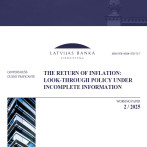Inflation and wage race: which one will win the cup?

Lately, the purchasing power of Latvia's population continues on a downward trend. Data for the second quarter of 2022 suggest that the average renumeration in Latvia has risen by 8.3% year-on-year. In a context of low inflation, this indicator would imply a rapid improvement in welfare among the employed; however, at present, such rate of wage growth is also insufficient to offset the price surge. Prices, particularly those of energy and food, continued to rise briskly; as a result, the second quarter of this year saw inflation reach 16.4%, thus substantially reducing the population's real wages (the wage increase was nominal; yet in real terms, with the inflation growth subtracted, income fell).
If the current inflation growth persists, the purchasing power will keep declining, mostly affecting the less-paid population groups. The low unemployment rate, which continued to decline in the second quarter, currently serves as a factor stimulating the wage growth. The low unemployment rate causes labour shortage in the labour market, thus encouraging employers to offer more generous remuneration. Nevertheless, storm clouds are gradually gathering on the horizon, foreshadowing a possible negative effect on the remuneration trends.
The increase in energy prices dictates the rise in production costs that will trigger savings on other expenses, including wages. Yet, the situation varies greatly across sectors. This also concerns the gap between inflation and wage growth: overall, it witnessed an upward trend. However, there were sectors that did not see any significant changes and sectors that witnessed a very substantial average wage growth. For example, the sectors of agriculture, forestry and fishery, arts, entertainment and recreation, as well as transport and storage experienced a wage growth of 15.1%, 12.6% and 12.3 respectively. Meanwhile, the sectors of finance, insurance, other services and health care saw the lowest wage rise: 6.0%, 5.0% and 3.2% respectively. The situation differed from sector to sector. For instance, wages in the entertainment and recreation sector picked up after the pandemic, as previously several restrictions were in place and the sector was actually "on ice". One of the lowest wage rises in the health care sector can be explained by the fact that in the respective quarter of the last year the people employed in the above sector worked extra hours and received premiums for that. This year offers fewer opportunities to work overtime, thus having an adverse effect on the average wage growth.
In conclusion, it can be stated that the elevated inflation continues to be the key obstacle to the real wage growth, and the rate of price hikes will remain high in the near future. In light of the energy price issue, as well as the approaching economic challenges in different sectors, wage rise will, most likely, have some catching up to do. Thus, for the meantime we should be ready that the race between inflation and wages will unfortunately be led by inflation.
Textual error
«… …»






